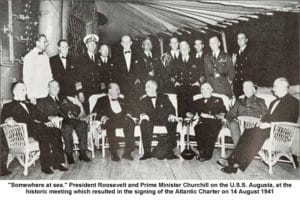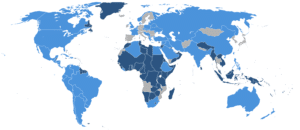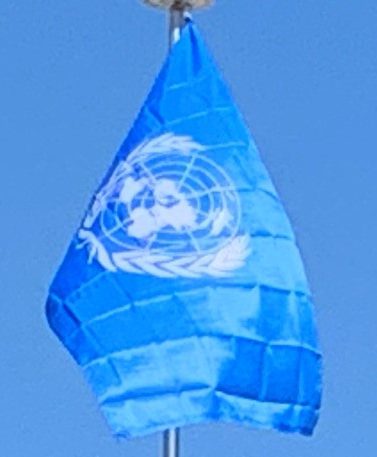
Being convinced that complete victory over their enemies is essential to defend life, liberty, independence and religious freedom, and to preserve human rights and justice in their own lands as well as in other lands, and that they are now engaged in a common struggle against savage and brutal forces seeking to subjugate the world,
DECLARE:
Each Government pledges itself to employ its full resources, military or economic, against those members of the Tripartite Pact and its adherents with which such government is at war.
Each Government pledges itself to cooperate with the Governments signatory hereto and not to make a separate armistice or peace with the enemies.
The foregoing declaration may be adhered to by other nations which are, or which may be, rendering material assistance and contributions in the struggle for victory over Hitlerism.
— The Washington Conference 1941–1942
During the war, “the United Nations” became the official term for the Allies. To join, countries had to sign the Declaration and declare war on the Axis.
Founding:
The UN was formulated and negotiated among the delegations from the Allied Big Four (the United States, the United Kingdom, the Soviet Union and China) at the Dumbarton Oaks Conference from 21 September 1944 to October 7, 1944 and they agreed on the aims, structure and functioning of the UN. After months of planning, the UN Conference on International Organization opened in San Francisco, 25 April 1945, attended by 50 governments and a number of non-governmental organizations involved in drafting the UN Charter. “The heads of the delegations of the sponsoring countries took turns as chairman of the plenary meetings: Anthony Eden, of Britain, Edward Stettinius, of the United States, T. V. Soong, of China, and Vyacheslav Molotov, of the Soviet Union. At the later meetings, Lord Halifax deputized for Mister Eden, Wellington Koo for T. V. Soong, and Mister Gromyko for Mister Molotov.” The UN officially came into existence 24 October 1945, upon ratification of the Charter by the five permanent members of the Security Council—France, the Republic of China, the Soviet Union, the UK and the US—and by a majority of the other 46 signatories.

The first meetings of the General Assembly, with 51 nations represented, and the Security Council took place in Methodist Central Hall, Westminster, London beginning on 10 January 1946. The General Assembly selected New York City as the site for the headquarters of the UN, construction began on 14 September 1948 and the facility was completed on 9 October 1952. Its site—like UN headquarters buildings in Geneva, Vienna, and Nairobi—is designated as international territory. The Norwegian Foreign Minister, Trygve Lie, was elected as the first UN Secretary-General.
Cold War Era:
Though the UN’s primary mandate was peacekeeping, the division between the US and USSR often paralyzed the organization, generally allowing it to intervene only in conflicts distant from the Cold War. Two notable exceptions were a Security Council resolution on 7 July 1950 authorizing a US-led coalition to repel the North Korean invasion of South Korea, passed in the absence of the USSR, and the signing of the Korean Armistice Agreement in 27 July 1953.
